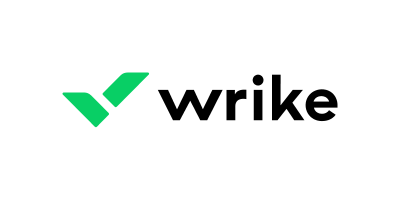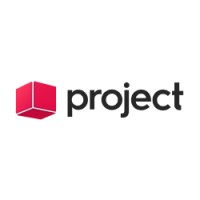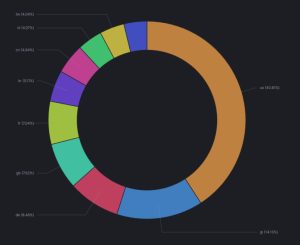Airtable’s fast factsPricing: Airtable paid plan starts at $10 per seat per month, billed annually. Standout features:
See if Airtable is the best project management tool for your team by trying its Pro plan for 14 days at no cost. |
Unique from other project management tools, the Airtable collaboration software boasts itself as a low-code relational database for building team applications, and my experience is that this is perhaps the most undervalued project management solution on the market. Backed by extensive configurability, affordable plans and innovative features, Airtable’s workflow capabilities can enhance nearly any team or project’s prospects.
SEE: Use our project manager hiring kit to find the best person to lead your project teams.
Airtable is a tool that aims to save your business time and money. We evaluate its features, pricing structure, and the real-world pros and cons of this powerful software. But if Airtable doesn’t meet your organization’s needs, we also reviewed some alternatives to help you determine the best project management software for your company.
Jump to:
Featured partners
Pricing
Airtable is an affordable project management software. It has a free plan plus three paid plans. The best plan for you depends on your required features and capabilities.
Free
Airtable’s Free plan is available to up to five users at no charge. It allows users to create unlimited bases with a limit of 1,200 records per base and per table. With Airtable’s Free plan, users get 2GB of storage space for attachments, up to 100 automation runs per month, and two weeks of revision and snapshots history.
This plan is ideal for individuals testing out Airtable to learn about its capabilities or a team of less than five working on basic data-driven projects.
Plus
The Plus plan costs $10 per seat per month when billed annually or $12 per seat per month when billed monthly. It is ideal for small teams or a sub-team with organizations looking to create connected apps or their own custom workflow.
Unlike the free plan that has 2GB storage, the Plus plan offers up to 5GB storage for attachments and supports up to 5,000 records per base and up to six months of revision and snapshot history. It also supports basic customization by allowing users to create custom branded forms. For the Plus plan, customer support’s initial response is 24 hours.
Pro
The Airtable Pro plan costs $20 per seat per month when billed annually or $24 per seat per month when billed monthly. This plan is suitable for midsize businesses, as it offers more records per base (50,000) compared to the lower-tier plans.
It supports Gantt chart and timeline views, as well as personal and locked views, which allows creators to hide their base by default from other collaborators, and sections views which enable users to organize their views in the sidebar. With this plan, users can get early access to new Airtable features as well as field and table editing permissions.
Enterprise
Airtable doesn’t advertise its Enterprise plan pricing on its website. Prospective buyers must contact their sales team for custom quotes.
This plan is ideal for large organizations with thousands of employees. It has up to 1,000GB of attachment space, giving users more storage than other tiers. And the response time for the Enterprise plan’s support team is 12 hours.
Key features of Airtable
Ability to import existing projects
Trying to import the same file across other top project management tools, none compare to the speed and accuracy of Airtable’s import engine. Most all require some level of reconciliation after import to ensure existing data matches the parameters of the platform; however, Airtable immediately recognized every field and required no additional action before moving forward (Figure A).
Figure A
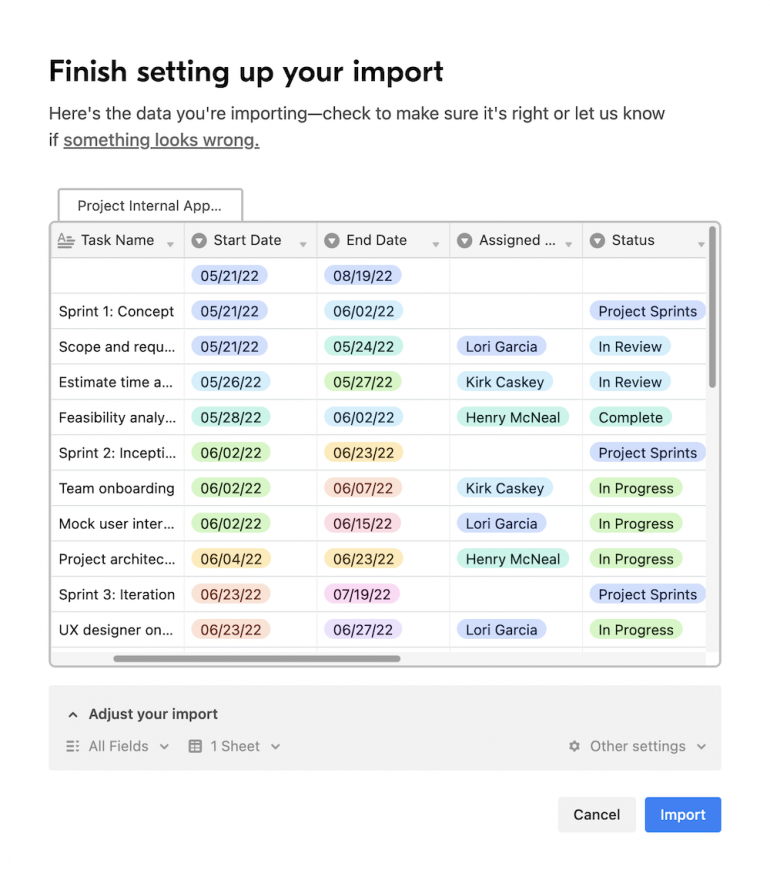
While I get the project rolling and configured on Airtable, I can avoid dragging other stakeholders into every step of the team onboarding process. For teams looking to import an existing project, Airtable hits the mark with an invaluable capability for avoiding duplicative work and manual inputting of project data.
Multiple project view types for managing project data
Change how you view project data with a handful of options to create different perspectives, including a classic grid, calendar, kanban-style board, Gantt chart and task gallery.
The Grid view is a familiar spreadsheet-like interface, where rows represent core records like tasks, ideas and clients with corresponding column values providing details like status or deadline.
Both Kanban and Gallery views offer a flexible way to drag and drop and modify tasks within the platform tab. While I struggled to find the benefit of the Gallery view, I appreciated the ability to drag and drop columns when initially re-ordering the different task statuses in the Kanban view (Figure B).
Figure B
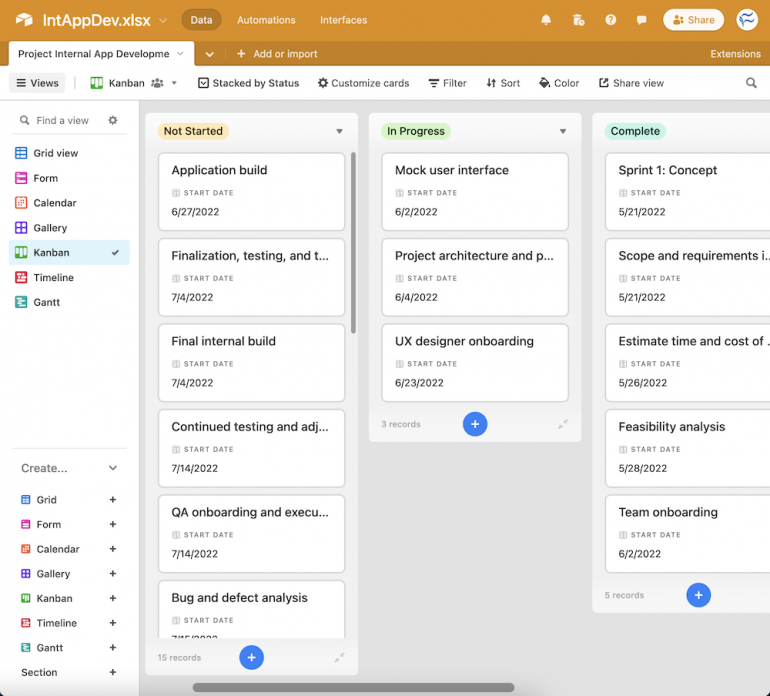
I experienced a hiccup when creating my calendar, Gantt and Timeline views, during which an Airtable widget seemed to jump over the start and end dates listed in the first few columns of my project. After troubleshooting the issue, I was able to fix the mistake, which was caused by a mislabelled column when importing a column over. The resulting Gantt chart (Figure C) enabled me to view the different workloads of team members based on Grid data using different colors.
Figure C
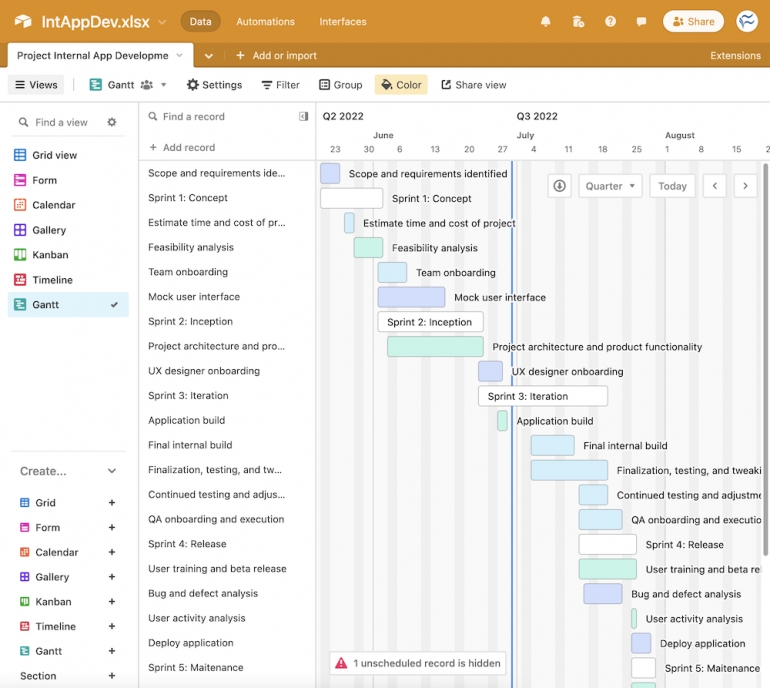
Extensions for connecting critical apps and workflows
The Extensions Marketplace “Airtable apps” offers teams over 40 Airtable-developed extensions, 20 scripts or the option to build a custom extension. From the “All extensions” tab, teams can access more than 150 open-source extensions through GitHub (Figure D).
Figure D
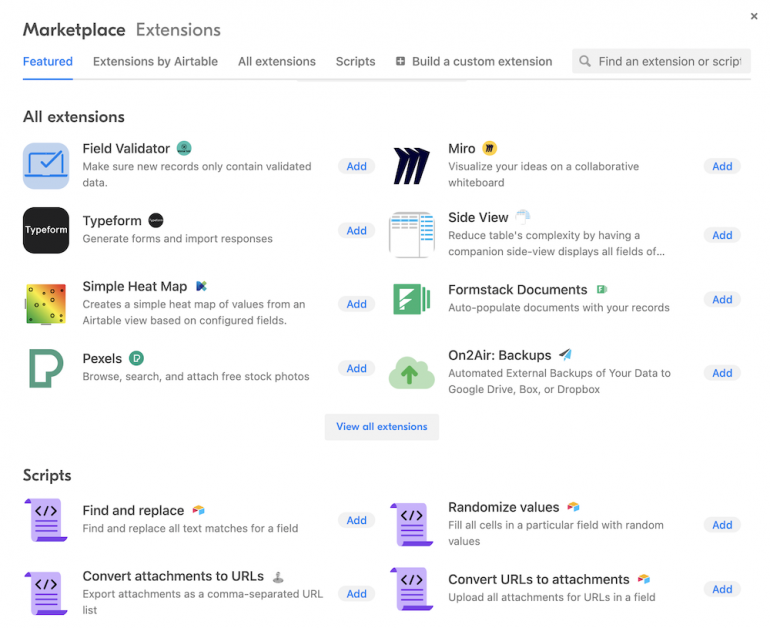
Scripts for executing built-in and custom workflows
The Scripts tab of Airtable Extensions provides users with several options to deploy prebuilt automations that validate emails, extract project metadata and assign team members tasks based on availability via a shift scheduler.
For code-friendly teams, users can access and edit a script’s assembly language to best fit team needs (Figure E). Furthermore, there’s also the option to build an extension with JavaScript, TypeScript, GitHub’s Remix, JSON files and a dozen other repos sourced from GitHub.
Figure E
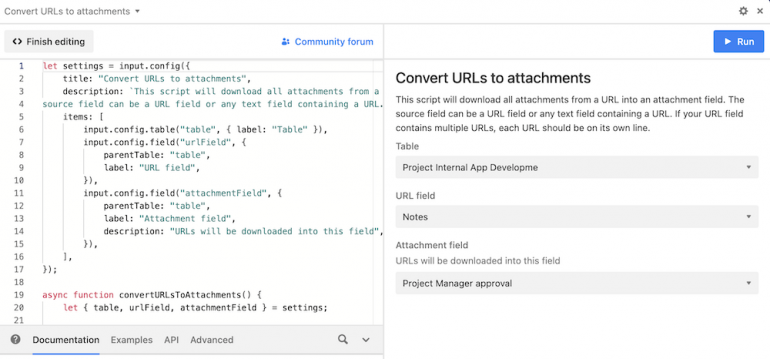
Project templates for setting up project parameters fast
Airtable offers a number of cross-industry templates on the platform. In Figure F, the template categories on the right-hand side shows Airtable’s functional range, while the cards featured are templates ideal for software development.
Figure F
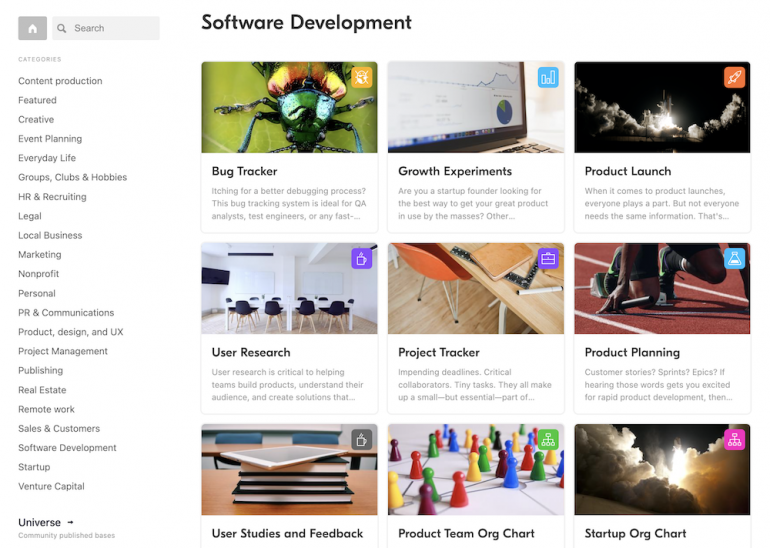
While there is plenty to appreciate for general and niche uses, I was disappointed not to see more developer-oriented templates. Navigating to the Airtable Universe (bottom-left) offers more to consider from a range of community-published templates for 22 different categories, including marketing and sales, real estate, product, design and UX, education and more.
Pros
- View, collect and modify data across multiple views with remote teams.
- Import process took a few clicks, loaded fast and accurately reflected existing data.
- A handy help menu and chat box when starting different tasks for the first time.
- All plans come with the Interface Designer to build and customize apps for internal or external use.
Cons
- Changing the primary column and adding subtasks in Grid view could be more intuitive.
- Import reconciliation required later to manage column types.
- Lagging when moving between views with extensive data or position movements.
- Limited extensions for two of the three business plans (three for Plus, 10 for Pro).
- Not a niche pick for software development teams.
Airtable integrations
For teams with needed integrations, Airtable’s extensions include a number of third-party applications for different functional teams:
- Miro: Brainstorm and work together through collaborative whiteboards via Miro.
- Jira Cloud: Import tasks and epics from Jira into project data.
- Google Workspace: Connect the team’s video conferencing application.
- BaseQL: Integrate the GraphQL API into Airtable project pipelines.
- Loom: Preview screen and video captures using Loom within the project.
- Tellephant: Connect the team’s WhatsApp Business Account to the platform.
- Typeform: Build and share forms and import responses into the Airtable platform.
- Formito: Transform project tables into data collection forms and chatbots.
- Data Fetcher: Employ no-code integrations for several additional applications.
Who is Airtable best for?
Airtable serves more than 300,000 teams through its cloud-based collaboration platform. Through exploring the company’s website and using the platform personally, Airtable has a universe of potential use cases and clients, including:
Use cases
- Bug tracking for software testing engineers and quality assurance analysts.
- Content calendar to create and manage editorial tasks for content production.
- Product launches with timelines, checklists, stakeholders and milestones to launch.
- Product operations to collect feedback, improve products and manage releases.
- Product roadmapping with a business value versus implementation complexity matrix.
- User research for tracking data, scheduling UX tests and analyzing insights.
Teams and clients
- Creative production and marketing.
- Engineering, IT and customer support.
- Finance, legal and human resources.
- Operations and manufacturing.
- Product and design.
- Sales and account management.
If Airtable isn’t ideal for you, check out these alternatives
| Software | Airtable | Trello | Asana | Notion |
|---|---|---|---|---|
| Time tracking | Yes | Requires Power-Ups | Yes | Requires add-on |
| Kanban boards | Yes | Yes | Yes | Yes |
| Gantt charts | Yes | No | Limited | Limited |
| Mobile app | Yes | Yes | Yes | Yes |
| Free plan | Yes | Yes | Yes | Yes |
| Starting price (billed annually) | $10 per seat per month | $5 per seat per month | $10.99 per user per month | $8 per user per month |
Trello

Trello’s project management is focused on the kanban board. With Trello, users can manage to-do lists, store and share files, set reminders and collaborate with teams. Both Trello and Airtable are on our lists of the best project management software for small businesses.
Compared to Airtable, Trello is more affordable, with rates starting from $5 per user per month when billed annually or $6 per user per month when billed monthly. Generally, Trello is ideal for those shopping for an easy-to-use Kanban task management solution.
For more information, read our full Trello review.
Asana

Asana project management tools help users monitor project progress, track individual tasks, plan sprints and organize their projects in order to meet deadlines. While Asana and Airtable offer comprehensive project management functionality, Asana is more user-friendly and easy to setup compared to Airtable, making it ideal for those looking to get started with a project management tool. Due to their generous free plans, we ranked them among the top free project management software.
For more information, read our full Asana review.
Notion

Notion is a productivity app designed for creators and creative teams to enable them document their thoughts, manage projects or create wikis to help users find information quickly and easily.
Airtable strength lies in data management, while Notion standout as a knowledge management tool. If you looking for a tool to help you organize and manage your data, then consider Airtable. Notion is the best option if you need a tool to organize documents and manage information.
For more information, read our full Notion review.
Review methodology
This review is based on our experience registering, configuring and executing a project in Airtable. We familiarized ourselves with Airtable’s product documentation, demos, industry reviews and recognition and a comparative analysis with alternative software applications.
If you’re still not sure if Airtable is the best tool for you, check out our extended list of some of the best Airtable alternatives.
Feature partners
1 Wrike
Tackle complex projects with Wrike’s award-winning project management software. Break projects into simple steps, assign tasks to team members, and visualize progress with Gantt charts, Kanban boards, and calendars. Manage resource allocation and forecasting with software that’s easy to launch. Automation and AI features strip away time-consuming admin tasks so you can do the best work of your life. Streamline your practices, align your team, and ensure you hit deadlines and stay on budget.
2 monday.com
monday.com Work OS is the project management software that helps you and your team plan, execute, and track projects and workflows in one collaborative space. Manage everything from simple to complex projects more efficiently with the help of visual boards, 200+ ready-made templates, clever no-code automations, and easy integrations. In addition, custom dashboards simplify reporting, so you can evaluate your progress and make data-driven decisions.
3 Rocketlane
Rocketlane is purpose-built to run customer facing projects. It uniquely ties project management, document collaboration, and communication to help teams hit their project goals, accelerate time-to-value, and elevate the customer experience.
4 Cerri Project
Cerri Project is a comprehensive PPM solution integrating project portfolio management and strategic planning features to drive value for your business.
Strategic execution of project portfolios, business initiatives and objectives.
Global capacity planning and visibility.
Streamlined workflows with process-driven project management.
5 GanttPRO
Powerful intuitive app to schedule projects in minutes! GanttPRO has all the key elements of classic Gantt charts and introduces indispensable features for project manager: advanced task management, progress tracking, resource and cost management, team collaboration, task time tracking, baselines, project export and sharing, and more.
Pull up a chair and get reading. There’s more info about Airtable with these articles on how to use it as a project management tool and how to use it to make an online form.
Source of Article
